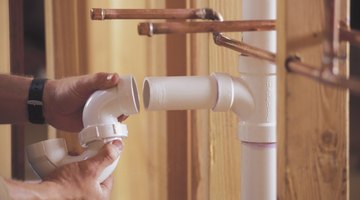Pipe Stub in Vs. Stub on
Piping intersections can take the form of a Y or T shape. Connections for branch pipes are made with pipe tees or stub-ins. Capped and unused pipe branch connections or stubs on pipes are called stub outs.

Pipe Tees
A pipe tee has three branches. A pipe tee is called a reducing tee when the branch pipe has a smaller diameter than the main pipe. The two large holes fit to the main pipe. The third hole is a stub on which the branch pipe can be connected. The branch pipe hole can be capped and left as a stub out until used.
Pipe Stub Out
Pipe stub outs are pipes that stick out from a wall or pipe tee. Stub outs are also called stub-ups. They are capped until a branch pipe is attached. The branch pipe can be inserted after the pipe cap is removed.
Pipe Stub In
Stub-ins can replace a reducing tee in joining branch pipes. A hole the diameter of the stub-in pipe is drilled into the main pipe and the pipes are fitted together. The stub-in pipe and main pipe are then welded together. Pipe stub-in connections avoid the cost of buying pipe fittings and also save installation time because only one weld is needed around the stub hole instead of three times around the two joins to the main pipe and connections.
The Drip Cap
- Piping intersections can take the form of a Y or T shape.
- A pipe tee has three branches.
- The third hole is a stub on which the branch pipe can be connected.
- Stub-ins can replace a reducing tee in joining branch pipes.
References
Resources
Writer Bio
My expertise includes product data management software. I provide first and second level technical support for this class of software as well as write FAQs, user manuals and troubleshooting guides for first level staff. My personal finance expertise has been showcased repeatedly on "The Dollar Stretcher" frugal living website and magazine.
Photo Credits
- Comstock/Comstock/Getty Images
- Comstock/Comstock/Getty Images
More Articles



